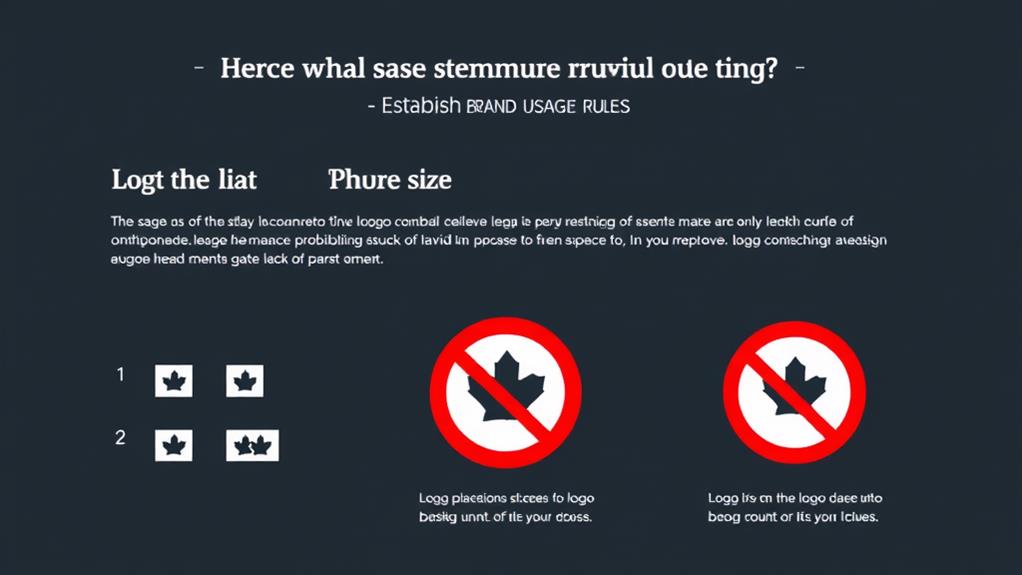How to Create a Brand Style Guide for Your Business
Creating a brand style guide is essential for ensuring a consistent and recognizable identity for your business. Start by defining your brand's purpose and identifying your target audience. Develop a distinct brand voice that resonates emotionally with customers. Choose visual elements, including a color palette and typography, to enhance brand recognition. Establish clear rules for logo usage and imagery to maintain visual integrity. Finally, articulate brand messaging guidelines that communicate your value proposition effectively. Consistent implementation and regular updates of this guide will elevate your brand's impact and relationship with customers. Discover additional insights to craft an effective guide.
Key Takeaways
- Define your brand purpose to connect emotionally with your audience and differentiate from competitors.
- Identify your target audience through demographic analysis and market research for effective marketing strategies.
- Develop a consistent brand voice by establishing tone, language, and personality traits that resonate with your audience.
- Choose visual elements, including a cohesive color palette and typography, to enhance brand recognition and convey your brand identity.
- Create clear guidelines for logo usage and imagery to maintain consistency and professionalism across all platforms.
Define Your Brand Purpose

What drives your brand to exist in a competitive marketplace? At the core of your brand lies its purpose, a compelling brand mission that articulates why your organization exists beyond profit generation. This mission serves as the guiding star for your operations, influencing every decision and action.
Defining your brand purpose involves establishing core values that resonate with both your internal team and your customers. These values not only reflect your business vision but also shape the social impact your brand seeks to achieve.
In today's market, consumers gravitate towards brands that embody authenticity and commitment to meaningful change, enhancing customer experience and loyalty.
Moreover, a clearly defined brand purpose provides a competitive advantage by differentiating your business in crowded spaces. It helps in shaping your brand story, a narrative that connects emotionally with your audience and articulates your unique market positioning.
When customers can relate to your mission and values, they are more likely to engage with your brand on a deeper level.
Identify Your Target Audience
Understanding your brand purpose lays the foundation for identifying your target audience. To effectively engage consumers, brands must explore demographic analysis, scrutinizing age, gender, income, and education levels. This data serves as a springboard for audience segmentation, allowing businesses to categorize potential customers into distinct groups based on shared characteristics.
Market research plays a pivotal role in this process. By gathering insights through surveys, focus groups, and competitive analysis, brands can construct detailed user personas. These personas personify the segments identified, providing a clear picture of customer motivations and preferences. This clarity enables the development of tailored engagement strategies that resonate deeply with each audience segment.
Moreover, understanding behavior patterns and lifestyle insights is essential. Analyzing how target audiences interact with your brand—and the broader market—can reveal critical touchpoints for engagement. Implementing feedback loops, where customer opinions inform product development and marketing strategies, creates a responsive brand that evolves alongside its audience.
Ultimately, a thorough understanding of your target audience not only enhances brand communication but also drives loyalty and conversion rates. By strategically leveraging demographic analysis, audience segmentation, and market research, businesses can guarantee their messaging is both relevant and impactful.
This process equips brands with the tools necessary to foster meaningful connections, paving the way for sustained growth and success in an increasingly competitive landscape.
Develop Your Brand Voice

To effectively engage your audience, it is essential to define your brand's tone and language, ensuring consistency across all communications.
Establishing clear brand personality traits will further enhance recognition and foster a deeper connection with your target market.
Define Tone and Language
Establishing a clear tone and language is vital for developing a cohesive brand voice that resonates with your target audience. Your tone should reflect your brand's essence, whether it's friendly, authoritative, or innovative.
Consider tone examples that align with your brand's values, ensuring language consistency across all platforms to enhance audience engagement.
Incorporating emotional resonance into your communication style can deepen connections with your audience. Utilize brand storytelling to convey messages that evoke feelings and foster loyalty.
It's important to balance colloquial vs formal language, adapting your tone to suit different contexts while maintaining message clarity.
Cultural considerations must also inform your tone and language choices, as they can greatly impact how your message is perceived. Aim for voice adaptability, as flexibility allows your brand to navigate various demographics and platforms without losing its core identity.
Ultimately, a well-defined tone and language not only clarify your brand's message but also enhance its ability to engage and resonate emotionally with your audience, creating lasting connections that drive growth and loyalty.
Establish Brand Personality Traits
A brand's personality traits serve as the foundation for its voice, shaping how it interacts with the audience and differentiating it from competitors. Establishing these traits involves selecting brand archetypes that resonate with your target market, allowing for a clear representation on the personality spectrum. This strategic alignment fosters emotional connections, enhancing customer perception and loyalty.
To effectively convey your brand's personality, leverage storytelling elements that reflect your values and mission. Integrate cultural influences that resonate with your audience, ensuring your brand authenticity shines through. This authenticity not only builds trust but also serves as a tool for competitive differentiation in a crowded marketplace.
Identify key personality traits—be it playful, sophisticated, or adventurous—that align with your overarching brand strategy. Consistently embody these traits across all communications to create a cohesive experience for your audience.
Choose Your Visual Elements
While visual elements serve as the cornerstone of your brand's identity, selecting the right components is essential for effective communication. A well-crafted visual language can notably enhance your brand's recognition and appeal, driving deeper connections with your audience. The key to this lies in understanding and implementing visual hierarchy and brand imagery.
Visual hierarchy plays a significant role in guiding viewers' attention to the most important aspects of your messaging. By strategically arranging elements such as typography, imagery, and layout, you can create a seamless flow that leads the viewer's eye. Prioritize essential information, ensuring that your core message stands out prominently.
Utilize scale, contrast, and spacing to reinforce this hierarchy, allowing your audience to navigate your content effortlessly.
Brand imagery encompasses the photographs, illustrations, and icons that represent your business visually. Selecting imagery that aligns with your brand's personality is critical; it should evoke the emotions and values you wish to communicate.
Consider the tone of your brand—whether it is playful, serious, or innovative—and choose images that resonate accordingly. Consistency in style and quality across all visual assets will foster a cohesive brand identity, enhancing trust and familiarity among your audience.
Create a Color Palette

A well-defined color palette is essential for establishing a cohesive brand identity.
Begin by selecting primary colors that reflect your brand's personality, followed by carefully chosen accent shades to enhance visual appeal.
Consistency in color usage will reinforce recognition and foster trust among your audience.
Choosing Primary Colors
Selecting primary colors is a critical step in crafting a cohesive brand identity that resonates with your target audience. The choice of colors will not only define your visual presence but also evoke specific emotional impacts based on color psychology.
Understanding the cultural significance of colors in your target market can enhance connection and relatability, guaranteeing your brand stands out.
Conducting a thorough competitor analysis allows you to identify industry standards and avoid color overlaps that dilute branding consistency. Additionally, consider seasonal trends; certain colors may resonate more strongly at specific times of the year, influencing consumer perception and engagement.
Accessibility considerations are paramount, as your color palette should promote inclusivity for all users. It's vital to select colors that maintain legibility and visual appeal across various platforms.
Ultimately, the primary colors you choose should align with your brand's mission and values, creating a memorable experience for your audience.
Selecting Accent Shades
Accent shades play an essential role in enhancing your primary color palette and can greatly impact the overall perception of your brand. Understanding accent shade psychology is fundamental; these colors evoke specific emotions and associations that can strengthen your brand narrative.
When selecting accent shades, consider current accent shade trends that resonate with your target audience while complementing your primary colors through effective accent shade pairing.
Accessibility is also a significant factor; choose shades that are visually appealing and functional across various platforms, ensuring that your brand remains inclusive. This involves selecting accent shades that maintain clarity and visibility in different applications, such as digital media, print, and merchandise.
The impact of accent shades should not be underestimated; they can guide consumer attention, highlight key elements, and enhance brand recognition.
By strategically integrating accent shades into your branding, you create a cohesive visual identity that communicates your values and engages your audience effectively.
Ultimately, the right accent shades, when applied thoughtfully, will elevate your brand and foster a lasting connection with your customers.
Ensuring Color Consistency
While establishing a cohesive brand identity, guaranteeing color consistency across all platforms is essential for maintaining recognition and trust. A well-defined color palette not only reflects your brand's personality but also leverages color psychology to evoke the desired emotional impact on your audience.
Understanding the cultural significance of colors in your target market is vital, as it can influence perceptions and behaviors.
To create a successful color palette, consider the following:
- Accessibility considerations: Guarantee your color choices are inclusive for all users, including those with visual impairments.
- Contrasting colors: Use contrasting colors to enhance readability and engagement, particularly in digital vs print contexts.
- Seasonal variations: Adapt your palette subtly for seasonal campaigns while maintaining core brand colors.
- Industry trends: Stay updated on color trends within your industry to remain relevant and appealing.
- Testing and feedback: Regularly test your color palette across various media and gather feedback to guarantee consistency and effectiveness.
Incorporating these elements will not only strengthen your brand identity but also foster deeper connections with your audience.
Select Typography Guidelines
Typography serves as a vital element in establishing a brand's visual identity, influencing how messages are perceived and interpreted by the audience. Selecting the right typography guidelines is essential to create a coherent and engaging brand experience. This process begins with defining a clear typography hierarchy that guides the reader's eye, ensuring that important information stands out while maintaining readability across various platforms.
Start by choosing a primary typeface that embodies your brand's essence—be it modern, classic, or playful. This typeface will serve as the anchor of your typography hierarchy. Next, consider font pairings that complement your primary choice. A well-thought-out pairing can enhance the overall design and help delineate different content types, such as headings, subheadings, and body text. For instance, a sans-serif font may work beautifully alongside a serif typeface, creating a striking contrast that captures attention.
Establish guidelines for font sizes, line heights, and letter spacing to maintain consistency. These elements are essential in reinforcing your brand's voice and ensuring a pleasant reading experience.
Finally, document your typography choices in your brand style guide, including specific use cases and incorrect applications. This clarity will empower your team and collaborators to maintain brand integrity across all communications, ultimately solidifying your brand's identity in the marketplace.
Mastering typography is not merely about aesthetics; it is a strategic approach to conveying your message effectively and memorably.
Establish Logo Usage Rules

Establishing logo usage rules is essential for maintaining brand consistency and integrity.
Clearly defining logo size specifications and color variation guidelines guarantees that your brand is presented uniformly across all platforms.
Logo Size Specifications
Consistently adhering to logo size specifications is essential for maintaining brand integrity and recognition. Establishing clear guidelines helps guarantee that your logo is presented consistently across all platforms, enhancing its visibility and impact.
To effectively manage your logo's application, consider the following key elements:
- Logo Placement Guidelines: Outline where the logo will appear across various materials, from print to digital.
- Logo Clearspace Requirements: Define the minimum clearspace around the logo to maintain visibility and prevent clutter.
- Logo File Formats: Specify acceptable file formats (e.g., PNG, SVG, EPS) to guarantee versatility and quality in reproduction.
- Logo Scalability Considerations: Ensure your logo remains impactful at different sizes, from social media icons to billboards.
- Logo Usage Examples: Provide visual examples of proper and improper logo usage to clarify expectations.
Understanding these specifications will empower your team to utilize the logo effectively and consistently.
Color Variations Guidelines
Maintaining a cohesive brand identity requires careful attention to color variations of your logo. Each variation serves a strategic purpose, reflecting your brand's emotions while adhering to color psychology principles.
Consider how different colors evoke distinct feelings and guarantee that your logo's colors resonate with your target audience. Establish clear rules for color usage, focusing on contrast balance to enhance visibility across various mediums.
Adhering to accessibility standards is essential; confirm that your color choices support readability for all users. Incorporate seasonal palettes judiciously, allowing your brand to remain relevant without compromising its core identity.
Be mindful of cultural implications associated with specific colors, as these can greatly impact audience perception. Differentiate between digital and print applications, as colors may appear differently across platforms.
Create guidelines that address these variations to maintain consistency. Lastly, stay informed about color trends to keep your brand fresh and engaging.
Outline Imagery and Graphics
Imagery and graphics play a pivotal role in shaping a brand's identity and messaging. A well-defined visual strategy not only enhances recognition but also conveys your brand's values and personality. To achieve this, it is vital to outline the various elements that will contribute to a cohesive brand image.
Begin by specifying the imagery styles that align with your brand's ethos, such as realistic versus abstract or minimalist versus elaborate. Next, determine the graphic formats you will use across different platforms, guaranteeing compatibility and adaptability.
Establishing a clear visual hierarchy allows for effective communication of your primary messages through size, color, and placement. Consider your approach to image sourcing—whether you will utilize original branding photography, stock images, or illustrations. Each choice carries implications for authenticity and relatability.
Additionally, delineate the types of illustrations and iconography choices that will resonate with your audience and enhance your content. Consistency is essential; make certain that all graphic elements adhere to your established guidelines to reinforce brand recognition. This includes aligning with color palettes, typography, and overall design aesthetics.
To summarize, an effective outline for imagery and graphics should encompass:
- Defined imagery styles
- Specified graphic formats
- Established visual hierarchy
- Clear image sourcing strategies
- Consistent illustration and iconography choices
Write Brand Messaging Guidelines

While crafting your brand messaging guidelines, it is essential to establish a clear and compelling narrative that resonates with your target audience. Successful brand messaging hinges on understanding your audience's needs and preferences, enabling effective audience engagement and fostering deeper connections.
Begin by articulating your positioning statement, a succinct declaration that defines your brand's unique place in the market. This statement should stem from a thorough competitive analysis, highlighting your distinct value proposition and allowing you to differentiate yourself from competitors.
Key messages are the cornerstones of your brand storytelling. These messages should convey your brand promises—the commitments you make to your customers. Make certain that they are aligned with your overall strategic goals and resonate emotionally with your audience, as this emotional connection is pivotal in building brand loyalty.
Next, establish a messaging hierarchy to prioritize your key messages. This hierarchy will guide your communications, making sure that the most important information is conveyed effectively. Each level of the hierarchy should support the overarching narrative while remaining adaptable to different channels and formats.
Incorporating these elements into your brand messaging guidelines not only clarifies your communication strategy but also empowers your team to create cohesive content that reflects your brand's identity and values.
Ultimately, a well-defined messaging framework solidifies your brand's presence in the marketplace and enhances audience engagement, driving long-term success.
Implement and Update Your Guide
A well-crafted brand style guide is only as effective as its implementation and ongoing updates. To guarantee your brand guide remains relevant and impactful, it is imperative to integrate its principles into every aspect of your business.
This process requires a strategic approach where all team members understand and value the guide as a cornerstone of brand identity.
Key elements for successful brand guide implementation and regular updates include:
- Training Sessions: Conduct workshops to familiarize your team with the guide's content and importance.
- Accessible Documentation: Guarantee the guide is easily accessible online, allowing for quick reference during projects.
- Feedback Mechanism: Establish a system for team members to provide input on the guide's effectiveness and applicability.
- Scheduled Reviews: Set specific times for reviewing and revising the guide, guaranteeing it evolves alongside market trends and audience expectations.
- Consistent Enforcement: Hold teams accountable for adhering to the guidelines in their communications and marketing materials.
Frequently Asked Questions
How Often Should I Update My Brand Style Guide?
Updating your brand style guide is essential for maintaining relevance and consistency.
Ideally, reviews should occur annually or in tandem with significant brand evolution or design revisions. This guarantees that the guide remains aligned with current market trends, audience expectations, and organizational goals.
Can I Create a Brand Style Guide Without a Marketing Team?
Yes, you can create a brand style guide without a marketing team.
Think of it as crafting a compass for your brand identity, guiding your visual elements, brand voice, and design principles.
Start by defining your target audience and brand values, ensuring consistency across all touchpoints.
With diligence and creativity, you can masterfully construct a thorough guide that encapsulates your brand's essence, empowering your team to communicate effectively and cohesively.
What Tools Can I Use to Design My Brand Style Guide?
To effectively design your brand style guide, leveraging the right tools is essential.
Consider utilizing design software such as Adobe Illustrator or Canva, which offer robust features for visual creation.
Additionally, explore template resources available online that provide pre-designed frameworks, enabling you to streamline your process.
How Do I Ensure Consistency Across Different Platforms?
Ensuring consistency across different platforms is essential for maintaining a strong visual identity and cohesive brand voice.
A strategic approach involves developing thorough guidelines that outline specific design elements, typography, and color schemes, as well as tone and messaging.
Regular audits of your communications across platforms will help identify discrepancies.
Implementing a centralized repository for all branding assets will facilitate access and adherence, fostering uniformity that enhances recognition and trust among your audience.
Is a Brand Style Guide Necessary for Small Businesses?
A brand style guide is essential for small businesses seeking to establish a strong brand identity.
It provides a cohesive framework that outlines visual elements such as logos, color palettes, and typography. This consistency not only enhances brand recognition but also fosters trust among consumers.
Conclusion
In summary, a brand style guide serves as the compass for a business, steering its identity through the complexities of the market. Just as a lighthouse guides ships safely to shore, a well-crafted guide illuminates the path for consistent branding and messaging. Statistics indicate that consistent branding can increase revenue by up to 23%. Consequently, establishing clear guidelines not only fosters coherence but also enhances recognition and trust among consumers, ultimately contributing to long-term success.




